Donkey Kong (series): Difference between revisions
From the Super Mario Wiki, the Mario encyclopedia
Jump to navigationJump to search
mNo edit summary |
mNo edit summary |
||
| Line 2: | Line 2: | ||
{{about|the Donkey Kong series of games|the entire franchise|[[Donkey Kong (franchise)]]}} | {{about|the Donkey Kong series of games|the entire franchise|[[Donkey Kong (franchise)]]}} | ||
{{series infobox | {{series infobox | ||
|image=[[File:Donkey Kong Logo. | |image=[[File:Donkey Kong Arcade Logo.png|300px]] | ||
|first=''[[Donkey Kong (game)|Donkey Kong]]'' ([[List of games by date#1981|1981]]) | |first=''[[Donkey Kong (game)|Donkey Kong]]'' ([[List of games by date#1981|1981]]) | ||
|latest=''[[Mario vs. Donkey Kong]]'' ([[List of games by date#2004|2004]]) | |latest=''[[Mario vs. Donkey Kong]]'' ([[List of games by date#2004|2004]]) | ||
| Line 21: | Line 21: | ||
!colspan="2" style="font-size:125%;text-align:left"|''[[Donkey Kong (game)|Donkey Kong]]'' | !colspan="2" style="font-size:125%;text-align:left"|''[[Donkey Kong (game)|Donkey Kong]]'' | ||
|- | |- | ||
|style="text-align:center"|[[File:Donkey Kong Arcade side art.png|145x145px]]<span style="font-size:8pt"><br>{{release|Japan|1981}}Arcade | |style="text-align:center"|[[File:Donkey Kong Arcade side art.png|145x145px]]<span style="font-size:8pt"><br>{{release|Japan|1981}}Arcade</span> | ||
|In [[List of games by date#1981|1981]], Nintendo had their first blockbuster release with [[Shigeru Miyamoto]]'s creation - ''Donkey Kong''. Originally released in the arcades, ''Donkey Kong'' became a very popular game amongst gamers, eventually spawning many remakes and ports. In this game, [[Donkey Kong]] was the antagonist who kidnapped [[Mario]]'s girlfriend Lady (later renamed [[Pauline]]). It was later ported to the many home systems including the Atari 2600, the ColecoVision and the Nintendo Entertainment System. This is a simple platformer, where the player must control Mario while jumping and avoiding obstacles and making it to Donkey Kong. | |In [[List of games by date#1981|1981]], Nintendo had their first blockbuster release with [[Shigeru Miyamoto]]'s creation - ''Donkey Kong''. Originally released in the arcades, ''Donkey Kong'' became a very popular game amongst gamers, eventually spawning many remakes and ports. In this game, [[Donkey Kong]] was the antagonist who kidnapped [[Mario]]'s girlfriend Lady (later renamed [[Pauline]]). It was later ported to the many home systems including the Atari 2600, the ColecoVision and the Nintendo Entertainment System. This is a simple platformer, where the player must control Mario while jumping and avoiding obstacles and making it to Donkey Kong. | ||
|- | |- | ||
!colspan="2" style="font-size:125%;text-align:left"|''[[Donkey Kong Jr. (game)|Donkey Kong Jr.]]'' | !colspan="2" style="font-size:125%;text-align:left"|''[[Donkey Kong Jr. (game)|Donkey Kong Jr.]]'' | ||
|- | |- | ||
|style="text-align:center"|[[File:Donkey Kong Jr Arcade side art.png|145x145px]]<span style="font-size:8pt"><br>{{release|Japan|1982}}Arcade | |style="text-align:center"|[[File:Donkey Kong Jr Arcade side art.png|145x145px]]<span style="font-size:8pt"><br>{{release|Japan|1982}}Arcade | ||
|The following year, another arcade game was created, ''Donkey Kong Jr.'' This time, the roles were reversed. Mario was the villain, and DK was a damsel in distress. Here, [[Donkey Kong Jr.]], Donkey Kong's son, had to save his kidnapped father from Mario. The gameplay is the same as the original Donkey Kong; Donkey Kong Jr. must avoid traps set off by Mario to save Donkey Kong by jumping and simply avoiding them. | |The following year, another arcade game was created, ''Donkey Kong Jr.'' This time, the roles were reversed. Mario was the villain, and DK was a damsel in distress. Here, [[Donkey Kong Jr.]], Donkey Kong's son, had to save his kidnapped father from Mario. The gameplay is the same as the original Donkey Kong; Donkey Kong Jr. must avoid traps set off by Mario to save Donkey Kong by jumping and simply avoiding them. | ||
|- | |- | ||
!colspan="2" style="font-size:125%;text-align:left"|''[[Donkey Kong 3]]''</span> | !colspan="2" style="font-size:125%;text-align:left"|''[[Donkey Kong 3]]''</span> | ||
|- | |- | ||
|style="text-align:center"|[[File:DK3 Arcade Cabinet Artwork.png|145x145px]]<span style="font-size:8pt"><br>{{release|Japan|1983}}Arcade | |style="text-align:center"|[[File:DK3 Arcade Cabinet Artwork.png|145x145px]]<span style="font-size:8pt"><br>{{release|Japan|1983}}Arcade | ||
|''Donkey Kong 3'' was the third installment of the ''Donkey Kong'' series, where [[Stanley]] fought Donkey Kong. This game differed from its predecessors in that it is a shooter/platformer hybrid and did not include Mario as a character. | |''Donkey Kong 3'' was the third installment of the ''Donkey Kong'' series, where [[Stanley]] fought Donkey Kong. This game differed from its predecessors in that it is a shooter/platformer hybrid and did not include Mario as a character. | ||
|- | |- | ||
!colspan="2" style="font-size:125%;text-align:left"|''[[Donkey Kong Jr. Math]]''</span> | !colspan="2" style="font-size:125%;text-align:left"|''[[Donkey Kong Jr. Math]]''</span> | ||
|- | |- | ||
|style="text-align:center"|[[File:Dk jr math box.jpg|145x145px]]<span style="font-size:8pt"><br>{{release|Japan|1983}}NES | |style="text-align:center"|[[File:Dk jr math box.jpg|145x145px]]<span style="font-size:8pt"><br>{{release|Japan|1983}}[[Nintendo Entertainment System|NES]] | ||
|''Donkey Kong Jr. Math'' was Donkey Kong Jr.'s second game, an edutainment title released in 1983 for the NES. Donkey Kong will hold up a sign, and Donkey Kong Jr. must find the numbers and math sign to get to that number to get a point. | |''Donkey Kong Jr. Math'' was Donkey Kong Jr.'s second game, an edutainment title released in 1983 for the NES. Donkey Kong will hold up a sign, and Donkey Kong Jr. must find the numbers and math sign to get to that number to get a point. | ||
|- | |- | ||
| Line 46: | Line 46: | ||
!colspan="2" style="font-size:125%;text-align:left"|[[Donkey Kong (Game Boy)|''Donkey Kong'' (Game Boy)]] | !colspan="2" style="font-size:125%;text-align:left"|[[Donkey Kong (Game Boy)|''Donkey Kong'' (Game Boy)]] | ||
|- | |- | ||
|style="text-align:center"|[[File:DKGBBoxAmerica.jpg|145x145px]]<span style="font-size:8pt"><br>{{release|Japan|1994}}Game Boy</span> | |style="text-align:center"|[[File:DKGBBoxAmerica.jpg|145x145px]]<span style="font-size:8pt"><br>{{release|Japan|1994}}[[Game Boy]]</span> | ||
|''Donkey Kong'' (also known as ''Game Boy Donkey Kong'' and ''Donkey Kong '94'') is the first ''Donkey Kong'' [[Game Boy]] title in the series. The [[Construction Site|Start]] is based on the original arcade version of ''[[Donkey Kong (game)|Donkey Kong]]'', but the rest of the game is greatly expanded and entirely different. | |''Donkey Kong'' (also known as ''Game Boy Donkey Kong'' and ''Donkey Kong '94'') is the first ''Donkey Kong'' [[Game Boy]] title in the series. The [[Construction Site|Start]] is based on the original arcade version of ''[[Donkey Kong (game)|Donkey Kong]]'', but the rest of the game is greatly expanded and entirely different. | ||
|- | |- | ||
| Line 71: | Line 71: | ||
!colspan="2" style="font-size:125%;text-align:left"|''[[Donkey Kong Jr. (Game & Watch)|Donkey Kong Jr.]]'' | !colspan="2" style="font-size:125%;text-align:left"|''[[Donkey Kong Jr. (Game & Watch)|Donkey Kong Jr.]]'' | ||
|- | |- | ||
|style="text-align:center"|[[File:Dkjrgw.jpg|145x145px]]<span style="font-size:8pt"><br> | |style="text-align:center"|[[File:Dkjrgw.jpg|145x145px]]<span style="font-size:8pt"><br>October 26, 1982<br>Game & Watch</span> | ||
|'''''Donkey Kong Jr.''''' is a ''[[Game & Watch]]'' edition of ''[[Donkey Kong Jr. (game)|Donkey Kong Jr.]]'', based on the first level of the arcade game of the same name. As in the original arcade game, [[Donkey Kong]] is captured by [[Mario]], and [[Donkey Kong Jr.]] must save him. There are two major revisions - the original version in the New Wide Screen series, and the colorized game in the Table Top and Panorama Screen series released the following year with an entirely different level and obstacle layout. Only the New Wide Screen version was ported to ''[[Game & Watch Gallery 3]]'', ''[[Game & Watch Gallery 4]]'', and [[DSiWare]]. The game also has an indirect sequel in the form of ''[[Donkey Kong II]]'', based on later levels of the arcade game. | |'''''Donkey Kong Jr.''''' is a ''[[Game & Watch]]'' edition of ''[[Donkey Kong Jr. (game)|Donkey Kong Jr.]]'', based on the first level of the arcade game of the same name. As in the original arcade game, [[Donkey Kong]] is captured by [[Mario]], and [[Donkey Kong Jr.]] must save him. There are two major revisions - the original version in the New Wide Screen series, and the colorized game in the Table Top and Panorama Screen series released the following year with an entirely different level and obstacle layout. Only the New Wide Screen version was ported to ''[[Game & Watch Gallery 3]]'', ''[[Game & Watch Gallery 4]]'', and [[DSiWare]]. The game also has an indirect sequel in the form of ''[[Donkey Kong II]]'', based on later levels of the arcade game. | ||
|- | |- | ||
!colspan="2" style="font-size:125%;text-align:left"|''[[Donkey Kong II]]'' | !colspan="2" style="font-size:125%;text-align:left"|''[[Donkey Kong II]]'' | ||
|- | |- | ||
|style="text-align:center"|[[File:GaW DK2.png|145x145px]]<span style="font-size:8pt"><br>{{release|USA|1983}} | |style="text-align:center"|[[File:GaW DK2.png|145x145px]]<span style="font-size:8pt"><br>{{release|USA|1983}} Game & Watch</span> | ||
|''Donkey Kong II'' is a [[Game & Watch]] game that is very similar to ''Donkey Kong Jr.'' It is based on the third and fourth levels of Donkey Kong Jr. and has the same plotline, but Mario is absent (except as an alarm sprite). Its gameplay involves Donkey Kong Jr. unlocking several chains to free Donkey Kong. It was later re-released as part of ''[[Game & Watch Gallery 3]]''. | |''Donkey Kong II'' is a [[Game & Watch]] game that is very similar to ''Donkey Kong Jr.'' It is based on the third and fourth levels of Donkey Kong Jr. and has the same plotline, but Mario is absent (except as an alarm sprite). Its gameplay involves Donkey Kong Jr. unlocking several chains to free Donkey Kong. It was later re-released as part of ''[[Game & Watch Gallery 3]]''. | ||
|- | |- | ||
!colspan="2" style="font-size:125%;text-align:left"|''[[Donkey Kong 3 (Game & Watch)|Donkey Kong 3]]'' | !colspan="2" style="font-size:125%;text-align:left"|''[[Donkey Kong 3 (Game & Watch)|Donkey Kong 3]]'' | ||
|- | |- | ||
|style="text-align:center"|[[File:Game_watch_donkey_kong_3-1-.jpg|145x145px]]<span style="font-size:8pt"><br>August 20, 1984<br> | |style="text-align:center"|[[File:Game_watch_donkey_kong_3-1-.jpg|145x145px]]<span style="font-size:8pt"><br>August 20, 1984<br>Game & Watch</span> | ||
|'''''Donkey Kong 3''''' is a [[Game & Watch]] title for either one or two players, released on August 20, 1984.<ref>[http://www.intheattic.co.uk/donkey_kong_3.htm ''Donkey Kong 3'' info page on In The Attic, a website dedicated to classic videogames] Retrieved 13 November 2010</ref> It was later included as a minigame in ''[[Game & Watch Gallery 4]]''. | |'''''Donkey Kong 3''''' is a [[Game & Watch]] title for either one or two players, released on August 20, 1984.<ref>[http://www.intheattic.co.uk/donkey_kong_3.htm ''Donkey Kong 3'' info page on In The Attic, a website dedicated to classic videogames] Retrieved 13 November 2010</ref> It was later included as a minigame in ''[[Game & Watch Gallery 4]]''. | ||
|- | |- | ||
| Line 105: | Line 105: | ||
!colspan="2" style="font-size:125%;text-align:left"|''[[Donkey Kong Jr. + Jr. Sansū Lesson]]'' | !colspan="2" style="font-size:125%;text-align:left"|''[[Donkey Kong Jr. + Jr. Sansū Lesson]]'' | ||
|- | |- | ||
|style="text-align:center"|[[File:Ss dkjr sl.png|145x145px]]<span style="font-size:8pt"><span style="font-size:8pt"><br>{{release|Japan|1983}}[[ | |style="text-align:center"|[[File:Ss dkjr sl.png|145x145px]]<span style="font-size:8pt"><span style="font-size:8pt"><br>{{release|Japan|1983}}[[Family Computer|Famicom]]</span> | ||
|'''''Donkey Kong Jr. + Jr. Sansū Lesson''''' was released exclusively as the pack-in game for the {{wp|Sharp Nintendo Television|Sharp C1 Famicom TV}}, a combined [[Family Computer]] and television unit in Japan. It is a compilation of the games ''[[Donkey Kong Jr. (game)|Donkey Kong Jr.]]'' and ''[[Donkey Kong Jr. Math]]''. The game is not exactly a combination, but rather a "platter" of the two ''[[Donkey Kong (series)|Donkey Kong]]''-related games. It combines half of the 1- and 2-Player game modes from ''Donkey Kong Jr''. and the +-×÷ Exercise mode from ''Donkey Kong Jr. Math''. The latter is from the prototype version as ''Donkey Kong Jr. Math'' was still in development upon this game's release. | |'''''Donkey Kong Jr. + Jr. Sansū Lesson''''' was released exclusively as the pack-in game for the {{wp|Sharp Nintendo Television|Sharp C1 Famicom TV}}, a combined [[Family Computer]] and television unit in Japan. It is a compilation of the games ''[[Donkey Kong Jr. (game)|Donkey Kong Jr.]]'' and ''[[Donkey Kong Jr. Math]]''. The game is not exactly a combination, but rather a "platter" of the two ''[[Donkey Kong (series)|Donkey Kong]]''-related games. It combines half of the 1- and 2-Player game modes from ''Donkey Kong Jr''. and the +-×÷ Exercise mode from ''Donkey Kong Jr. Math''. The latter is from the prototype version as ''Donkey Kong Jr. Math'' was still in development upon this game's release. | ||
|- | |- | ||
| Line 115: | Line 115: | ||
!colspan="2" style="font-size:125%;text-align:left"|''[[Donkey Kong/Donkey Kong Jr./Mario Bros.]]'' | !colspan="2" style="font-size:125%;text-align:left"|''[[Donkey Kong/Donkey Kong Jr./Mario Bros.]]'' | ||
|- | |- | ||
|style="text-align:center"|[[File:DK DKjr MB upright.png|145x145px]]<span style="font-size:8pt"><br>{{release|USA|2004}}Arcade | |style="text-align:center"|[[File:DK DKjr MB upright.png|145x145px]]<span style="font-size:8pt"><br>{{release|USA|2004}}Arcade</span> | ||
|'''''Donkey Kong/Donkey Kong Jr./Mario Bros.''''' is an arcade system, only found in America, in which players could choose which of the three games they wanted to play. | |'''''Donkey Kong/Donkey Kong Jr./Mario Bros.''''' is an arcade system, only found in America, in which players could choose which of the three games they wanted to play. | ||
|} | |} | ||
| Line 134: | Line 134: | ||
!colspan="2" style="font-size:125%;text-align:left"|''[[Donkey Kong 64]]'' | !colspan="2" style="font-size:125%;text-align:left"|''[[Donkey Kong 64]]'' | ||
|- | |- | ||
|style="text-align:center"|[[File:Dk64.jpg|145x145px]]<span style="font-size:8pt"><br>{{release|Europe|1999}}Nintendo 64</span> | |style="text-align:center"|[[File:Dk64.jpg|145x145px]]<span style="font-size:8pt"><br>{{release|Europe|1999}}[[Nintendo 64]]</span> | ||
|''Donkey Kong 64'' included the entire arcade version of the original ''[[Donkey Kong (game)|Donkey Kong]]'' as a [[minigame]] which had to be played to complete the game. | |''Donkey Kong 64'' included the entire arcade version of the original ''[[Donkey Kong (game)|Donkey Kong]]'' as a [[minigame]] which had to be played to complete the game. | ||
| | ||
Revision as of 07:34, January 2, 2024
- This article is about the Donkey Kong series of games. For the entire franchise, see Donkey Kong (franchise).
| Donkey Kong | |
|---|---|

| |
| First installment | Donkey Kong (1981) |
| Latest installment | Mario vs. Donkey Kong (2004) |
| Franchise | Donkey Kong |
The Donkey Kong series is a video game series in the Donkey Kong franchise, starting with the original 1981 arcade game of the same name.
List of games
| Title | |
|---|---|
| Cover, original release and system | Synopsis |
| Donkey Kong | |
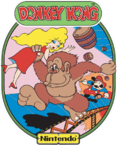 Arcade |
In 1981, Nintendo had their first blockbuster release with Shigeru Miyamoto's creation - Donkey Kong. Originally released in the arcades, Donkey Kong became a very popular game amongst gamers, eventually spawning many remakes and ports. In this game, Donkey Kong was the antagonist who kidnapped Mario's girlfriend Lady (later renamed Pauline). It was later ported to the many home systems including the Atari 2600, the ColecoVision and the Nintendo Entertainment System. This is a simple platformer, where the player must control Mario while jumping and avoiding obstacles and making it to Donkey Kong. |
| Donkey Kong Jr. | |
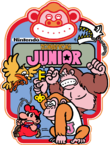 Arcade |
The following year, another arcade game was created, Donkey Kong Jr. This time, the roles were reversed. Mario was the villain, and DK was a damsel in distress. Here, Donkey Kong Jr., Donkey Kong's son, had to save his kidnapped father from Mario. The gameplay is the same as the original Donkey Kong; Donkey Kong Jr. must avoid traps set off by Mario to save Donkey Kong by jumping and simply avoiding them. |
| Donkey Kong 3 | |
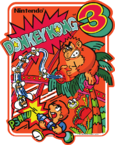 Arcade |
Donkey Kong 3 was the third installment of the Donkey Kong series, where Stanley fought Donkey Kong. This game differed from its predecessors in that it is a shooter/platformer hybrid and did not include Mario as a character. |
| Donkey Kong Jr. Math | |
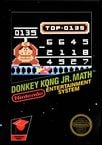 NES |
Donkey Kong Jr. Math was Donkey Kong Jr.'s second game, an edutainment title released in 1983 for the NES. Donkey Kong will hold up a sign, and Donkey Kong Jr. must find the numbers and math sign to get to that number to get a point. |
| Donkey Kong 3: Dai Gyakushū | |
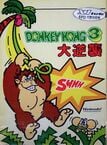 NEC PC-6601/PC8801/X1 |
An obscure Japanese-only sequel to Donkey Kong 3, Donkey Kong 3: Dai Gyakushū was developed and released by Hudson Soft for home computers in 1984. The gameplay is simplified compared to its forebear, with Stanley's ability to jump removed, along with the need to protect plants, making it much closer to something like Galaga. |
| Donkey Kong (Game Boy) | |
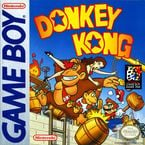 Game Boy |
Donkey Kong (also known as Game Boy Donkey Kong and Donkey Kong '94) is the first Donkey Kong Game Boy title in the series. The Start is based on the original arcade version of Donkey Kong, but the rest of the game is greatly expanded and entirely different. |
| Mario vs. Donkey Kong | |
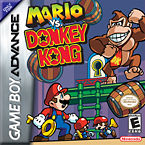 Game Boy Advance |
Mario vs. Donkey Kong is the final title in the original Donkey Kong series and is a successor to the Game Boy game (of which it was originally intended to be a direct remake). In it, Donkey Kong steals several toy Mini Marios and Mario goes to recover them. It spawned a spinoff series of its own with wildly different gameplay mechanics. |
Game & Watch
| Title | |
|---|---|
| Cover, original release and system | Synopsis |
| Donkey Kong | |
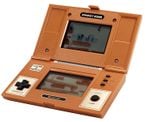 Game & Watch |
Donkey Kong is a dual-screen Game & Watch version of the classic arcade game. The game was later ported to Game & Watch Gallery 2 and Game & Watch Gallery 4. |
| Donkey Kong Jr. | |
 October 26, 1982 Game & Watch |
Donkey Kong Jr. is a Game & Watch edition of Donkey Kong Jr., based on the first level of the arcade game of the same name. As in the original arcade game, Donkey Kong is captured by Mario, and Donkey Kong Jr. must save him. There are two major revisions - the original version in the New Wide Screen series, and the colorized game in the Table Top and Panorama Screen series released the following year with an entirely different level and obstacle layout. Only the New Wide Screen version was ported to Game & Watch Gallery 3, Game & Watch Gallery 4, and DSiWare. The game also has an indirect sequel in the form of Donkey Kong II, based on later levels of the arcade game. |
| Donkey Kong II | |
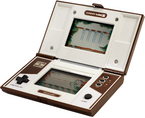 Game & Watch |
Donkey Kong II is a Game & Watch game that is very similar to Donkey Kong Jr. It is based on the third and fourth levels of Donkey Kong Jr. and has the same plotline, but Mario is absent (except as an alarm sprite). Its gameplay involves Donkey Kong Jr. unlocking several chains to free Donkey Kong. It was later re-released as part of Game & Watch Gallery 3. |
| Donkey Kong 3 | |
 August 20, 1984 Game & Watch |
Donkey Kong 3 is a Game & Watch title for either one or two players, released on August 20, 1984.[1] It was later included as a minigame in Game & Watch Gallery 4. |
| Donkey Kong Circus | |
 Game & Watch |
Donkey Kong Circus is a Game & Watch title released as part of the Panorama series. Donkey Kong is forced to juggle in a circus. If he messes up, Mario will laugh at him. |
| Donkey Kong Hockey | |
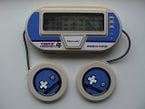 Game & Watch |
Donkey Kong Hockey is one of the few two-player Game & Watch games ever manufactured. Donkey Kong and Mario must engage each other in a two-player game of ice hockey. |
Compilations
| Title | |
|---|---|
| Cover, original release and system | Synopsis |
| Donkey Kong Jr. + Jr. Sansū Lesson | |
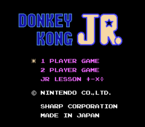 Famicom |
Donkey Kong Jr. + Jr. Sansū Lesson was released exclusively as the pack-in game for the Sharp C1 Famicom TV, a combined Family Computer and television unit in Japan. It is a compilation of the games Donkey Kong Jr. and Donkey Kong Jr. Math. The game is not exactly a combination, but rather a "platter" of the two Donkey Kong-related games. It combines half of the 1- and 2-Player game modes from Donkey Kong Jr. and the +-×÷ Exercise mode from Donkey Kong Jr. Math. The latter is from the prototype version as Donkey Kong Jr. Math was still in development upon this game's release. |
| Donkey Kong Classics | |
 NES |
Donkey Kong Classics is a video game collection of the Donkey Kong series, consisting of the games Donkey Kong and Donkey Kong Jr.. This compilation is for the Nintendo Entertainment System, which was developed by Nintendo EAD. |
| Donkey Kong/Donkey Kong Jr./Mario Bros. | |
 Arcade |
Donkey Kong/Donkey Kong Jr./Mario Bros. is an arcade system, only found in America, in which players could choose which of the three games they wanted to play. |
Related
| Title | |
|---|---|
| Cover, original release and system | Synopsis |
| Donkey Kong (Nelsonic Game Watch) | |
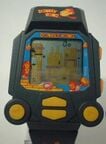 Nelsonic Game Watch |
The Donkey Kong game watch is an adaptation of Stage 1-7 from the Game Boy version. |
| Donkey Kong 64 | |
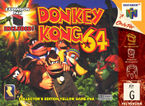 Nintendo 64 |
Donkey Kong 64 included the entire arcade version of the original Donkey Kong as a minigame which had to be played to complete the game.
|
Canceled
| Title | |
|---|---|
| Cover, original release and system | Synopsis |
| Donkey Kong no Ongaku Asobi | |
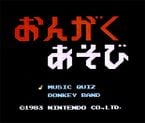 Unreleased Famicom |
Donkey Kong no Ongaku Asobi (Donkey Kong's Fun with Music) is a canceled game set for release on the Nintendo Entertainment System. It would have followed Donkey Kong Jr. Math as one of the edutainment games in the early Donkey Kong series. Donkey Kong no Ongaku Asobi starred the cast of the original Donkey Kong plus series newcomer Donkey Kong Jr. The game never surfaced, and seems to have only been announced in 1983 in a Japanese gaming magazine. |
| Return of Donkey Kong | |
Unreleased |
Return of Donkey Kong is a canceled Nintendo Entertainment System game announced in the Official Nintendo Player's Guide in 1987. Not much is known about the title. |
| Philips CD-i Donkey Kong game | |
Unreleased |
An untitled Donkey Kong game. It is likely that production stopped due to Donkey Kong being a separate license from Super Mario.[2] |
References
- ^ Donkey Kong 3 info page on In The Attic, a website dedicated to classic videogames Retrieved 13 November 2010
- ^ [1]